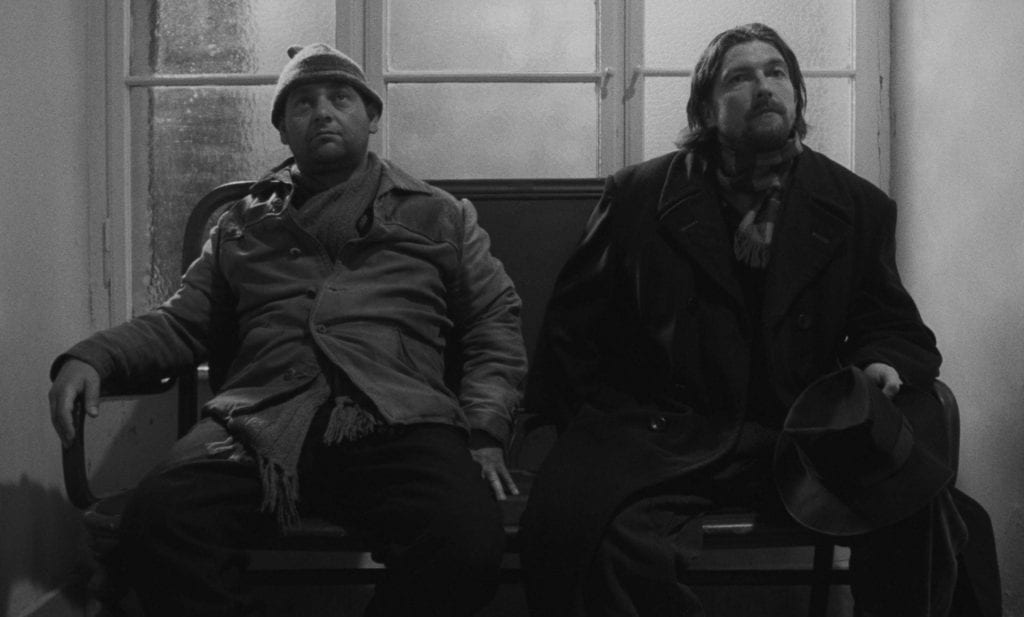
I was recently visited by a good friend named Max Westler, who drove down from Northern Indiana. Truth be told, he did not come to see me, but traveled to Bloomington to spend two days in IU Cinema, with the hook being Béla Tarr’s Sátántangó. Max is a brilliant published poet (retired creative writing professor from St. Mary’s) and cinephile who has been writing as long as he has been seeing films as a kid in NYC. We first connected after a screening of Jean-Pierre Melville’s Le Samourai in Michigan at the Vickers Theatre in 1997.
About a week after Max’s recent visit, he sent this email:
“Sorry, but I haven’t been able to stop thinking about Sátántangó, hence the attachment, for which I apologize. It seems that the only way I could get that film out of my head was to sit down and write something about it. Please excuse the academic tone. Great films don’t necessarily have to be perfect films, but they compel your attention, get under your skin and stay there. The word ‘haunting’ is overused in film reviews. But for me at least, and in spite of its excesses, Sátántangó was truly haunting.”
What follows is Max Westler’s literary exorcism of Sátántangó.
Those Bells
Sátántangó begins with a contradiction: the narrator tells us the bell tower of the church was long ago demolished, that the bells are defunct. And yet the sound of those bells ringing opens and closes the film. Which in turn suggests that the world we’re seeing turns on a contradiction between the materiality–the almost painfully exact rendering of the physical, the concrete, the particular (the stitch pattern on a woman’s sweater)–and something mysterious and unaccounted for, an essence, perhaps spiritual, conspicuous by its absence. At one point, Irimais and his two thug buddies encounter a swirling cloud of fog, and we get a reaction shot of their faces, and suddenly it’s a moment from every horror film we’ve ever seen. But no monster steps out of the fog. “Haven’t you ever seen fog before?” says one of the thugs, and they move on. But I’m guessing Béla Tarr wants us to see (or at least to think) something’s there. In any case, the bells, the ruined tower, brought to mind the following poem by the visionary poet Hart Crane (the guy who wrote that epic poem about Brooklyn Bridge):

The Broken Tower
The bell-rope that gathers God at dawn
Dispatches me as though I dropped down the knell
Of a spent day – to wander the cathedral lawn
From pit to crucifix, feet chill on steps from hell.
Have you not heard, have you not seen that corps
Of shadows in the tower, whose shoulders sway
Antiphonal carillons launched before
The stars are caught and hived in the sun’s ray?
The bells, I say, the bells break down their tower;
And swing I know not where. Their tongues engrave
Membrane through marrow, my long-scattered score
Of broken intervals… And I, their sexton slave!
Oval encyclicals in canyons heaping
The impasse high with choir. Banked voices slain!
Pagodas, campaniles with reveilles out leaping-
O terraced echoes prostrate on the plain!…
And so it was I entered the broken world
To trace the visionary company of love, its voice
An instant in the wind (I know not whither hurled)
But not for long to hold each desperate choice.
My word I poured. But was it cognate, scored
Of that tribunal monarch of the air
Whose thigh embronzes earth, strikes crystal Word
In wounds pledged once to hope – cleft to despair?
The steep encroachments of my blood left me
No answer (could blood hold such a lofty tower
As flings the question true?) -or is it she
Whose sweet mortality stirs latent power?-
And through whose pulse I hear, counting the strokes
My veins recall and add, revived and sure
The angelus of wars my chest evokes:
What I hold healed, original now, and pure…
And builds, within, a tower that is not stone
(Not stone can jacket heaven) – but slip
Of pebbles, – visible wings of silence sown
In azure circles, widening as they dip
The matrix of the heart, lift down the eye
That shrines the quiet lake and swells a tower…
The commodious, tall decorum of that sky
Unseals her earth, and lifts love in its shower.

Happy As Lazarro
As I said at the time, Sátántangó resonates with Happy As Lazarro in a few interesting ways. The workers in HAL are no better off in the city under a capitalist economy than they were living in the countryside under their feudal landlords. Of course their feudal landlords don’t seem to have fared much better in the city either. In Sátántangó the workers exchange meaningless repetition (“plodding, plodding, plodding”) for meaningless change. The big difference between the two films is that in HAL, the workers are connected one to the other by bonds of affection and culture; whereas in Sátántangó there’s absolutely nothing connecting those characters except physical proximity. Huddled all together for warmth, each is caught up in his or her own isolating dream. We see that same isolation when they’re all drunk together. It’s ironic that they’re never more creatures of repetition than when they’re trying to escape it by getting drunk. They’re like a bunch of wind-up toys. The cows we see roaming the barnyard at the beginning of the film (and the wild horses we see later) are free, but not for long: soon they’ll all be led to the slaughterhouse. Freedom is just another illusion.

Irimais
When I saw Irimais and his pals making their way down the alley, seemingly blowing apart everything in their path, I thought of the flowing passage from The Communist Manifesto, Marx describing the cataclysmic social and economic changes that followed in the wake of capitalism:
“The bourgeoisie, historically, has played a most revolutionary part. The bourgeoisie, wherever it has got the upper hand, has put an end to all feudal, patriarchal, idyllic relations. It has pitilessly torn asunder the motley feudal ties that bound man to his ‘natural superiors,’ and has left remaining no other nexus between man and man than naked self-interest, than callous ‘cash payment.’ It has drowned the most heavenly ecstasies of religious fervour, of chivalrous enthusiasm, of philistine sentimentalism, in the icy water of egotistical calculation. It has resolved personal worth into exchange value. And in place of the numberless and feasible chartered freedoms, has set up that single, unconscionable freedom — Free Trade. In one word, for exploitation, veiled by religious and political illusions, naked, shameless, direct, brutal exploitation.”
In E.M. Forster’s Howard’s End, Margret (the liberal humanist) complains to her fiancé Henry (the capitalist) the world he’s created is chaotic and disruptive. “Yes, but it’s good for business,” he answers dryly. In Sátántangó, Irimais first separates the workers from their homes, and then from each other. Waiting in the police station, he notes that the two clocks on the wall don’t tell the same time. Which turns out to be his philosophy of life. There are no fixed, absolute truths or values: all is chaos. Only individuals are absolute, the only virtue naked self-interest. Society is atomized, a war of the all against the all.

Estike
“I’m stronger than you are,” Estike says to the cat, thereby summing up all human history. Other characters in the film can be pathetic, scheming, bored and boring, shameless, corrupt, doctors who don’t cure, teachers who don’t teach; Estike is the only genuinely tragic figure. Looking through that greasy window into the bar–for me a haunting, soul-shaking image–she sees her future and rejects it and the moral emptiness it represents. Her suicide is the only redemptive act in the film. I can only think of one other film in which a dark world is redeemed (maybe) by a child’s suicide: Bresson’s Mouchette. In the end, Sátántangó is seven and a half hours of total desolation. The only child in the entire film commits suicide. Her mother has no concern for her. One of the first images we see is a woman douching herself (I’m assuming to prevent a pregnancy). If every child represents hope, a vote for the future, this is a world without hope, without a future.
But then there are those bells.
Sátántangó was screened at the IU Cinema earlier this semester as the conclusion to the Beyond Epic series.

Jon Vickers is the Founding Director of IU Cinema. He has been “building community” through film experiences since the early 1990s, having opened and built programs for three thriving art cinemas in the Midwest. Favorite film: Dead Man (Jim Jarmusch, 1995).